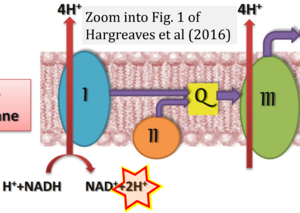Hargreaves 2016 Drug Saf
| Hargreaves IP, Al Shahrani M, Wainwright L, Heales SJR (2016) Drug-induced mitochondrial toxicity. Drug Saf 39:661–74. https://doi.org/10.1007/s40264-016-0417-x. |
Hargreaves IP, Al Shahrani M, Wainwright L, Heales SJR (2016) Drug Saf
Abstract: The mitochondrial respiratory chain (MRC) and ATP synthase (complex V) play an essential role in cellular energy production by the process of oxidative phosphorylation. In addition to inborn errors of metabolism, as well as secondary causes from disease pathophysiology, an impairment of oxidative phosphorylation can result from drug toxicity. These ‘off-target’ pharmacological effects can occur from a direct inhibition of MRC enzyme activity, an induction of mitochondrial oxidative stress, an uncoupling of oxidative phosphorylation, an impairment of mitochondrial membrane structure or a disruption in the replication of mitochondrial DNA. The purpose of this review is to focus on the off-target mitochondrial toxicity associated with both commonly used pharmacotherapies and a topical ‘weight loss’ agent. The mechanisms of drug-induced mitochondrial impairment will be discussed together with putative therapeutic strategies to counteract the adverse effects of the pharmacotherapy.
• Bioblast editor: Gnaiger E
Hydrogen ion ambiguities in the electron transfer system
Communicated by Gnaiger E (2023-10-08) last update 2023-11-10
- Electron (e-) transfer linked to hydrogen ion (hydron; H+) transfer is a fundamental concept in the field of bioenergetics, critical for understanding redox-coupled energy transformations.
- However, the current literature contains inconsistencies regarding H+ formation on the negative side of bioenergetic membranes, such as the matrix side of the mitochondrial inner membrane, when NADH is oxidized during oxidative phosphorylation (OXPHOS). Ambiguities arise when examining the oxidation of NADH by respiratory Complex I or succinate by Complex II.
- Oxidation of NADH or succinate involves a two-electron transfer of 2{H++e-} to FMN or FAD, respectively. Figures indicating a single electron e- transferred from NADH or succinate lack accuracy.
- The oxidized NAD+ is distinguished from NAD indicating nicotinamide adenine dinucleotide independent of oxidation state.
- NADH + H+ → NAD+ +2{H++e-} is the oxidation half-reaction in this H+-linked electron transfer represented as 2{H++e-} (Gnaiger 2023). Putative H+ formation shown as NADH → NAD+ + H+ conflicts with chemiosmotic coupling stoichiometries between H+ translocation across the coupling membrane and electron transfer to oxygen. Ensuring clarity in this complex field is imperative to tackle the apparent ambiguity crisis and prevent confusion, particularly in light of the increasing number of interdisciplinary publications on bioenergetics concerning diagnostic and clinical applications of OXPHOS analysis.
Labels: MiParea: Pharmacology;toxicology



